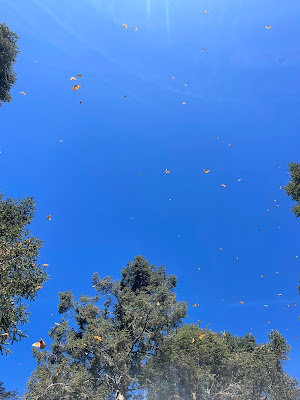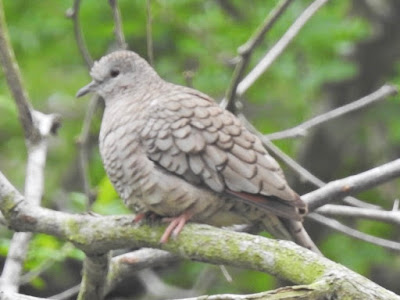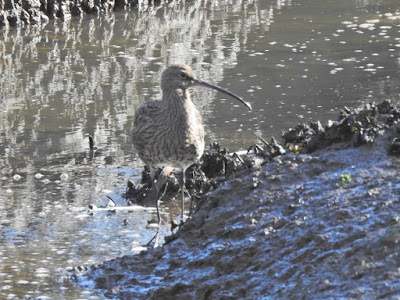Mexico is one of my favorite countries in the world. There’s a lot of shade that unfairly comes Mexico’s way. It’s close to the United States and the integration of Mexican culture in the US means it doesn’t feel as exotic as other foreign countries, and there are the (way overblown) perceived security issues.
Let’s set the record straight: Mexico kicks ass and, especially for nature travel, is extremely underrated. Name your environment and it’s there. Deserts, jungles, cloud forests, and everything in between allow for a rich variety of bird life. The geography with the high peaks and wide variety of habitat has created a hotbed for endemism too. Mexico ranks 11th in the world for the amount of bird species it has. 9 of the countries above it are either touching or within spitting distance of the equator and the other is China. So yeah, Mexico is teeming with opportunities to see some gnarly wildlife.
This time I wanted to get into the mountains and chase some of the endemics. I got a tip to stay near the Monarch Butterfly sanctuaries, as they weren’t far from Mexico City and also had good birding. I was kind of meh on the butterflies but I’ll take a lodge with walking access to trails! Plus, Mexico City was #1 on my city hit list. I booked a stay at Cerro Pelon in Macheros, which is a 30 minute drive from Zitacuaro, a 2.5 hour bus ride from Mexico City.
Dreamy birds like Mountain Trogon, Crescent-Chested Warbler, Bumblebee Hummingbird, and the iconic Red Warbler awaited me.
Traveling from Oklahoma City, weather in Houston meant that I arrived in CDMX hungry, stressed, and exhausted at 1 AM. A morning torta in Roma Norte fixed the hunger in the morning, but I was still worried about the logistics of getting to Macheros. I’d read online the bus station wasn’t in the best part of town and I was really worried about some kind of logistics issue with the bus that would delay me.
None of the concerns materialized. In fact, it was a breeze and the only issue was my credit card didn’t work and I had to pay cash. I walked up, bought my ticket, and was on the road 30 minutes later! The drive was great, and I easily got a taxi in Zitacuaro. All in all, the price of the bus and taxi was $80 roundtrip. EZ.
 |
| Slate-throated Redstart |
Macheros is more of a village than a small town right on the border of Michoacán and Estado de Mexico. There is one restaurant in town and no cell service. At 7,400 feet, it is surrounded by mountains that eclipse 11,000 feet and is surrounded by incredible pine-oak woodlands, which are one of my favorite habitats to bird. I had 1 full day here and another half day. The full day was set aside to go see the Monarchs, which when I booked were walkable and I would get to see birds while on the hike.
 |
| Macheros, Mexico |
After putting my stuff down, I hit the trail. At 3:30, the birding was bound to be suboptimal, and it was made worse by one of the dogs at the lodge deciding to accompany me up to the lookout. I loved the company, even if her chasing squirrels through the woods scared off birds. It was great to just be outside in the cool mountain air. I found some good spots to look for birds in the morning and even got lifers with Mexican Violetear, White-eared Hummingbird, and Hermit Warbler! At sunset I had a thrush. Merlin picked up Hermit Thrush, but my initial reaction was Russet Nightingale-Thrush. Upon further review, I couldn't count it. The thrush flew away so quickly that I could not get a picture, and the bill looked off to me. I couldn't in good conscience count it.
 |
| Mexican Violetear |
Overall, the birding was challenging due to the thick vegetation and tall trees. My warbler targets would be largely obscured, and it would be hard to find good vantage points. It was nowhere near as difficult as tropical lowlands, but it still wasn't easy.
Like all things in birding travel, plans change. For the second year in a row, the Monarchs went to a different part of the massive reserve. Hiking wasn’t an option and we would have to drive 90 minutes up a different mountain to find them. Ugh, the butterflies were supposed to be a bonus and the focus on the birds, not the other way around! A nature documentary on Mexico caused me to reevaluate my feelings. It turns out, seeing the butterflies is less of a cool experience and more of a spectacle. With some backup birding options in Mexico City, I was gonna roll with it.
 |
| Gray Silky-Flycatcher |
The butterfly tour began at 9, which actually allowed me to bird the nearby trail beforehand. It was in the mid-40s and the forest started to wake up juuuust as I had to leave, causing me to hear a lot more than I saw. Still, I had some highlights of Yellow-eyed Junco, Wilson’s Warbler, and Greater Pewee. It was impossible to get high up the hill, which I would later find out was the place to go, due to the tantalizing calls of Gray Silky-Flycatcher and Brown-backed Solitaire.
 |
| Hepatic Tanager |
The ride to the butterflies took a long time. It was 45 minutes by van, where we then got in a cattle car for another 45 minutes up a bumpy dirt road. The forest was nearly pristine, and it was killing me to not be able to stop and look for birds. This better be worth it.
It was.
As we got higher, we started to see individual Monarchs that were flying alongside us, as if they were guiding us. We topped out just below the tree line at over 11,000 feet. When we got there, we were told by the guide that the forest we were in was inaccessible to the public. Because of that we would get 45 minutes with the butterflies, as opposed to the 18 minutes at El Rosario and other popular reserves. I stumbled upon a gold mine.
Seeing the Monarchs is one of the craziest things I have ever seen in my life. They cling to fir trees overnight and need it to be about 55° before their body temperature warms up enough to fly. As a result, it's better to get there later in the morning to give them time to warm up before taking off. The side of the mountain matters as well. The western side of the mountain takes longer to warm up.
I'd seen them briefly on a National Geographic documentary, so I somewhat knew what was coming, but I was still thankfully underprepared for what lay ahead of me. Spirits were high in the group until we approached what looked to be a dead or dying tree. It was brown, the leaves were discolored, and the branches were drooping a little bit.
The tree was very much alive. Those brown leaves were Monarchs, and the branches were drooping because so many were hanging onto them. The sun had not fully hit them enough to wake them up, but looking through the binoculars I saw tens of thousands of butterflies on one tree, with the striking orange wings with black veins overlapping each other as the competed for every square millimeter.
My jaw hit the floor. I'm butterfly-curious at best and that left me unprepared for the sight in front of me. It was jarring. The group felt the same. The cheerful conversation came to abrupt stop, and silence lingered for the entire 45 minutes that we were there.
Butterflies fluttered overhead, they clung to trees, and they landed on all of us. Similar to migration fallout on the coast, we had to be careful not to step on any of them. Quite literally, there were at least a million. It wasn't the sight that was the craziest thing, it was the sound. You could hear the butterflies flying around you and in the sky. There were so many of them that there was no room for birds.
 |
| Pictures you can hear |
Think about the biggest beehive you've ever seen. Now replace that with Monarch Butterflies (and maybe a little less sound). That was what we were experiencing. The word "spectacle" gets thrown around a lot, maybe too much, but this was truly a spectacle. Before the trip I could have skipped this experience. Now, this is something that everyone, even non-nature enthusiasts, should have on their bucket list. Everything from the journey to the actual experience exceeded my most optimistic expectations. 
Something that was gnawing at me was that I hadn't really felt connected to nature in a while. The Panamanian highlands was the last time I felt that way. I felt connected again on that mountain. It was good to be back at it!
Leaving felt like a crime, but it had to happen. Our 2-hour trip home left me little time to bird, but I stuck the tips I got from Joel on where to see my targets. Unsurprisingly, I rolled snake eyes in the late afternoon. I had until 11 the next morning, and I needed to make it count.
I woke up early and skipped breakfast in order to maximize my time on the trail and I was moving before the sun came up at 7:15. I only had 3.5 hours.
 |
| That's no moss, those are all Monarchs |
The forest was very quiet and took time to wake up, probably until at least 8. There I was, below the oak tree where the trail forks in 3 directions. I'd seen Hermit, Yellow-rumped, Nashville, and Orange-crowned in that tree already. But none of my targets.
A distant call perked my ears up. It sounded like a trogon. I replayed the call on Merlin, definitely a Mountain Trogon. Here we go. I played the call as loud as my phone would go. We got a response, and I inched closer. There was a huge clearing that was being farmed, and the trogon was calling somewhere around there. I got within 50 feet of it, and after a long silence the call started again farther away. We were trying to find each other!
After 20 minutes I saw movement. This had to be it. I searched and searched, eyeing the red breast of a Mountain Trogon as it flew off yet again. Sprinting around a mountain at 7,000+ feet should exhaust you, but my adrenaline was PUMPING. I saw it, but only enough to get fleeting glimpses before it went quiet. That was enough for me, 1 target down! Now I was missing Green-striped Brushfinch, Bumblebee Hummingbird, Crescent-chested Warbler, and the most prized one of all, Red Warbler. It was now 8:45.
At this point I resolved to get to the point that Scott Olmstead mentioned in his checklists 7 years ago. I'd stop for any flocks, but the higher up I got, the more likely I felt like I would find my targets. Time to hustle.
 |
| White-eared Hummingbird |
Moving fast, I sped through the quiet forest, up to the other patch of oaks that I found earlier where things got incredibly steep. Basically, running, I startled 2 birds on the ground. The shade from the trees meant the ground was dark and these birds scurried off into the brush, but not before they could properly be identified! The biggest give aways were the low positioning and the bright white throat. Green-striped Brushfinch, my 5th most wanted target of the trip! I had #2 and #5 and had to keep going up.
Huffing and puffing, I reached the mirador. A short walk away was a relatively open clearing in the sun. The first bird I saw was Tufted Flycatcher. Sitting on an exposed branch, it would flutter and then flip to a steep dive before returning to its perch. The sunlight meant things were more active. The path went for maybe .15 miles before the point where I turned around. But this whole path was full of birds. Hummingbirds were different up here, just a few hundred feet above where the lodge was. White-eared Hummingbirds and Mexican Violetears were replaced with Blue-throated Mountain-gems and Rivoli's Hummingbirds.
 |
| Tufted Flycatcher |
I kept getting hung up on warblers that turned out to be Yellow-rumped, Nashville, or Orange-crowned. It was getting to be time to turn around, but I kept meticulously checking the warblers. One was different. Yellow breast, red smudge... could it be? Distinctive white eyebrow stripe! That's it!!! Crescent-chested Warbler! Relief washed over me. This is a mega in the United States, with a few Arizona records and 2 in Texas, but ever since I've been a birder I've wanted to see one of these because an adventure would be required to see one (and they look freaking sick). As cool as it would have to see one at Ramsey or Boot Canyon, seeing one in Mexico was much cooler.
 |
| Nashville Warbler |
With 60% of my targets and 45 minutes to spare, I was feeling good. I could stake out each oak patch for 15 minutes or so before I had to be back. Coming down instead going up was much easier, too, because I could see the treetops below me with a better vantage point.
I hit the first oak patch and sat on a rock with a perfect view of everything below me. My birding senses were tingling. Something felt right. 5 minutes of silence was all they needed. A flock moved in. This was my chance. In a sea of brown and dark green, my eyes locked onto a whisp of red like a missile. My heart rate went up as I fumbled with the binoculars.
Sitting there in my binoculars was one of the prettiest birds in the world, a Red Warbler. Solid red with bright white cheeks, this was a top 10 most wanted bird in the world for me. They are endemic to the Mexican highlands and were my motivation for coming to this area of the country. And they're stunning enough to make a birder out of anyone. It moved too much to get a picture through the trees, but I got a good few minutes to admire it, which is all that matters. In the span of 3 hours, I went from 0 to 4 of my targets.
The fun wasn't over. I didn't make it 200 yards before I found another flock. So much was moving around me. I finally got eyes on my lifer Gray Silky-Flycatcher, as well as tons of other warblers including another Crescent-chest. I tried to snipe one that was moving, but I realized I had the wrong warbler. This one was much brighter in the face, golden even, with a rufous triangular patch. No way, Golden-browed Warbler! I was in birding ecstasy. I spent 10 minutes soaking in views of both before a third incredible warbler entered the flock. Long time readers will know that Red-faced was my most wanted ABA bird from when I started birding. I saw tons in Arizona, but I missed them. Now, my thirst for one was quenched as I got to see another, very cooperative Red-faced Warbler. Incredible, I haven't had a birdgasm like this in a long time.
The only miss I had was Bumblebee Hummingbird, but it was on none of the checklists for the area I birded. People got them on the hike in the butterfly sanctuary, which was not an option for me. I had zero pain given how incredible my experience with Red Warbler was.
 |
| Red-faced Warbler (Cheating and using a pic I got from Arizona) |
The last 24 hours had been a whirlwind. One of the best nature experiences of my life was followed by epic birding and cleanup at the last second of my targets. In hindsight I should have spent another day up here, but Mexico City has been the #1 city in the world on my hitlist for a while so I wanted to maximize my time there. Knowing what I know about Mexico City closing on Mondays, I would have definitely stayed.
Getting back to CDMX was much easier than I thought it would be. I arranged to get picked up by the guy who dropped me off, and he took me directly to the bus station in Zitacuaro. The first counter I went to had a bus leaving in an hour and a half. I went to the next one, they had one leaving in 5 minutes. Credit cards did not work and I had to pay cash, which is the only heads up I can give. Arriving at the bus station I immediately hopped into an Uber and got to my hotel in Condensa. Don't let people scare you - the only stressful thing was making sure I could pee before my bus left.
 |
| Curve-billed Thrasher |
The most frustrating part of the trip came the next day, Monday. All of the museums are closed on Mondays, and I had 2 days in the city. Monday was going to be my birding day and Tuesday was going to be my museum day. Having learned my lesson from Kuching and Buenos Aires, I checked on the opening times of Bosque de Tlalpan before and was relieved to see they were 365 days! That was pre-Covid, and the website I found was not updated. Now it is also closed on Mondays, which I learned when I did a last second check before calling my Uber. Frustratingly, I went to the botanical garden at UNAM to look for Hooded Yellowthroat. Guess what - it was closed for construction even though their website mentioned nothing about construction! Maddening, but it wasn't meant to be. Spending a day walking to and from the Zocalo and getting more familiar with Mexico City was a good consolation prize.
 |
| Black-throated Gray Warbler |
That meant Tuesday, 12/31, was going to be a packed day. I was so happy with my Macheros birding that I didn't have any real targets besides maybe pictures of Red Warbler. That meant my major priority was the Museo de Antropologia, which is considered one of the best museums in the world. Originally I planned to go the Templo Mayor museum and Bellas Artes, but those would have to wait until I could come back with Christina. Despite the museum interest, I was here for birds, and it was time to see what Bosque de Tlalpan had to offer.
The park is very popular with joggers. The main trails are a little too busy for birds, but the side trails offer a ton. Getting there right as the sun was warming things was a great move. Things were initially due to a very vocal Broad-winged Hawk. I walked through about 75% of the park, and the best part was when I hit a scrubby side trail that was so full of birds that I stayed on it for at least an hour. Nashville and Yellow-rumped Warblers dominated, but every scan brought in another new bird. It felt like a migration day on the Texas coast, as there were 8 warblers in this flock, highlighted by a stunning Townsend's and Black-throated Gray, which is only the second one I have ever seen.
 |
| Blue Mockingbird |
The sun woke the birds up, and they were very active. The little hill looked out over one of the bougie areas of CDMX and the mountains loomed in the background. My expectations were being exceeded. And just when you think it can't get any better, it does. A lifer Blue Mockingbird was out in the open! After spending 5 hours looking for a vagrant at Carlsbad Caverns, it was nice to get one, and a great looking bird at that. The layered feather look, combined with the black mask and matted blue color was something no other mockingbird could imitate. Our Northern Mockingbirds would seethe with envy.
 |
| Rivoli's Hummingbird from SE Arizona |
The Blue Mockingbird's scene was over, but the nemesis theme was not done. There was a tough female oriole to identify, but I eventually was able to get it - Bullock's! While a female Bullock's Oriole is not the coolest looking bird, that dull orange bird in my binoculars was one of my biggest nemesis birds that was now vanquished. Brown-headed Nuthatch, YOU are now alone atop the nemesis list. My cool down for the trail was a Scott's Oriole, which isn't much of a cool down with how it gets the juices flowing.
 |
| Scott's Oriole |
The steep hills at that elevation were exhausting to climb up, but the views got better, the forest changed, and the birds were different. It was up here that I got my first really good look at Gray Silky Flycatcher, as well as Rivoli's Hummingbird. The only miss I had up here was Mexican Chickadee, which I ran out of time to look for due to the previous excitement. I can live with that. It was time to end my birding and go to the Museo de Antropolgia, which exceeded the hype as one of the best museums in the world.
 |
| Inca Doves were all over Mexico City |
I barely scratched the surface with my Mexican birding. There were plenty of endemics left in close proximity to the city that I didn't have to get to, like Black-polled Yellowthroat in Toluca or Sierra Madre Sparrow at Parque las Maravillas, and I can't wait to get back.
As for some final thoughts on the overall travel situation, because I got a lot of comments from people before I left, there were zero safety concerns. I still maintain that the only place I truly have felt unsafe is Cancun of all places. That includes walking around at night. I actually didn't go to Parque las Maravillas because I heard of safety issues, and I think that was a huge mistake based on what I know now (not that I really had time anyways). Unless you're doing something illegal or going to certain areas of Sinaloa, Mexico is completely safe.
 |
| Suadero was the best meat that I had in CDMX |
Much to the chagrin of Christina, Mexico City has now taken the top spot as my favorite city in the world. I stayed in Condensa and loved it. The food scene is the best in Latin America, if not the world and the museums are top notch. Thankfully, there is much there that is left to be seen, and Christina and I will be getting there as soon as Sydney allows us to.
 |
| This shrimp chile relleno taco from El Pescadito was probably the best taco I've had in my life |
Lastly, get to Macheros. Stay with Joel and Ana at Cerro Pelon B&B. We may not have Monarchs for much longer, enjoy the spectacle while you can. Birding that area is overlooked, which is a total mistake.
























